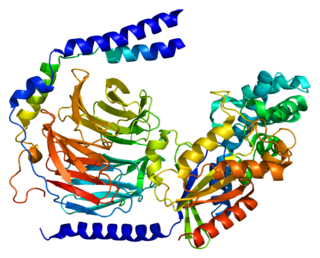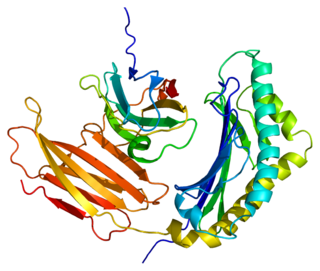Synucleins are a family of soluble proteins common to vertebrates, primarily expressed in neural tissue and in certain tumors.

Lymphotoxin beta receptor (LTBR), also known as tumor necrosis factor receptor superfamily member 3 (TNFRSF3), is a cell surface receptor for lymphotoxin involved in apoptosis and cytokine release. It is a member of the tumor necrosis factor receptor superfamily.

Beta-synuclein is a protein that in humans is encoded by the SNCB gene.

Disintegrin and metalloproteinase domain-containing protein 15 is an enzyme that in humans is encoded by the ADAM15 gene.

DnaJ homolog subfamily A member 3, mitochondrial, also known as Tumorous imaginal disc 1 (TID1), is a protein that in humans is encoded by the DNAJA3 gene on chromosome 16. This protein belongs to the DNAJ/Hsp40 protein family, which is known for binding and activating Hsp70 chaperone proteins to perform protein folding, degradation, and complex assembly. As a mitochondrial protein, it is involved in maintaining membrane potential and mitochondrial DNA (mtDNA) integrity, as well as cellular processes such as cell movement, growth, and death. Furthermore, it is associated with a broad range of diseases, including neurodegenerative diseases, inflammatory diseases, and cancers.

Laminin subunit gamma-2 is a protein that in humans is encoded by the LAMC2 gene.

Integrin beta-5 is a protein that in humans is encoded by the ITGB5 gene.

Suppressor of tumorigenicity 14 protein, also known as matriptase, is a protein that in humans is encoded by the ST14 gene. ST14 orthologs have been identified in most mammals for which complete genome data are available.

Guanine nucleotide-binding protein G(I)/G(S)/G(O) subunit gamma-2 is a protein that in humans is encoded by the GNG2 gene.

Matrix metalloproteinase-26 also known as matrilysin-2 and endometase is an enzyme that in humans is encoded by the MMP26 gene.

Stromelysin-3 (SL-3) also known as matrix metalloproteinase-11 (MMP-11) is an enzyme that in humans is encoded by the MMP11 gene.

Hypermethylated in cancer 1 protein is a protein that in humans is encoded by the HIC1 gene.

Protein tyrosine phosphatase type IVA 1 is an enzyme that in humans is encoded by the PTP4A1 gene.

Protein Wnt-7a is a protein that in humans is encoded by the WNT7A gene.

Prolactin-inducible protein also known as gross cystic disease fluid protein 15 (GCDFP-15), extra-parotid glycoprotein (EP-GP), gp17seminal actin-binding protein (SABP) or BRST2 is a protein that in humans is encoded by the PIP gene. It is upregulated by prolactin and androgens and downregulated by estrogen.

Dual specificity protein phosphatase 3 is an enzyme that in humans is encoded by the DUSP3 gene.

Hyaluronan synthase 3 is an enzyme that in humans is encoded by the HAS3 gene.

Low-density lipoprotein receptor-related protein 1B is a protein that in humans is encoded by the LRP1B gene.

Caveolin-2 is a protein that in humans is encoded by the CAV2 gene.

Transcription factor AP-2 gamma also known as AP2-gamma is a protein that in humans is encoded by the TFAP2C gene. AP2-gamma is a member of the activating protein 2 family of transcription factors.



















